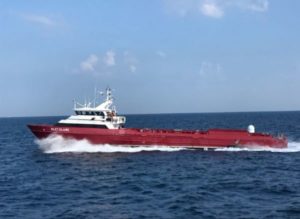The Navy awarded six companies contracts Friday for studies of a Large Unmanned Surface Vessel (LUSV) with a combined value of $42 million.
The winners are Huntington Ingalls Industries [HII], Lockheed Martin [LMT], Bollinger Shipyards Lockport LLCS, Fincantieri Marinette Marine, Gibbs & Cox Inc., and Austal USA, with each awarded firm-fixed price contracts with individual awards worth about $7 million each.

The contracts include options for engineering support that, if exercised, would raise the total combined value to $59 million.
Work will occur in various company facilities throughout the contiguous U.S. and is set to be finished by August 2021. If options are exercised, the work will last through May 2022.
The full value of $42 million is being obligated at time of award via FY ’20 Navy research, development, test and evaluation funds.
The Navy said the contracts were competitively procured with eight offers received, but did not disclose the two other competitors.
The service previously released a Request For Proposals to award multiple conceptual designs of LUSVs in September 2019, but strong congressional pushback has significantly revised the LUSV program schedule, leading to this smaller scale set of studies.
In the Navy’s FY 2021 budget request documents, the service revised the speed of LUSV development. The FY ’21 plan expected to award conceptual design contracts to multiple vendors in the fourth quarter of FY ’20, pushed back from previous plans in the second quarter. The detail design and construction contract was also pushed back to FY ’22 and the LUSV is only expected to transition to a program of record in FY ’23. The pace of procuring vessels was also slowed (Defense Daily, Feb. 14).
However, Congress’ work on their defense budget bills continues to limit the speed of LUSV development.
The House Armed Services’ defense authorization bill would prohibit procuring any LUSVs until a technology maturity certification is submitted to Congress. The certification focuses on assuring hull, mechanical, and electric systems have been developed and attained technology readiness levels of seven or higher and can be autonomously controlled for at least 30 days (Defense Daily, June 23).
The House authorization bill also requires the command and control system has been developed, can be operated autonomously, and has reached technology readiness level seven.
Separately, the Senate’s defense authorization bill sought similar measures, requiring the Navy to qualify subsystems like main engines and generators for unmanned vessels before moving to procurement (Defense Daily, June 11).
The Navy expects the LUSVs to be 200-300 feet long and a full load displacement of 1,000 to 2,000 tons, roughly the size of a corvette. It plans to eventually install vertical launch tubes for offensive action on LUSVs.